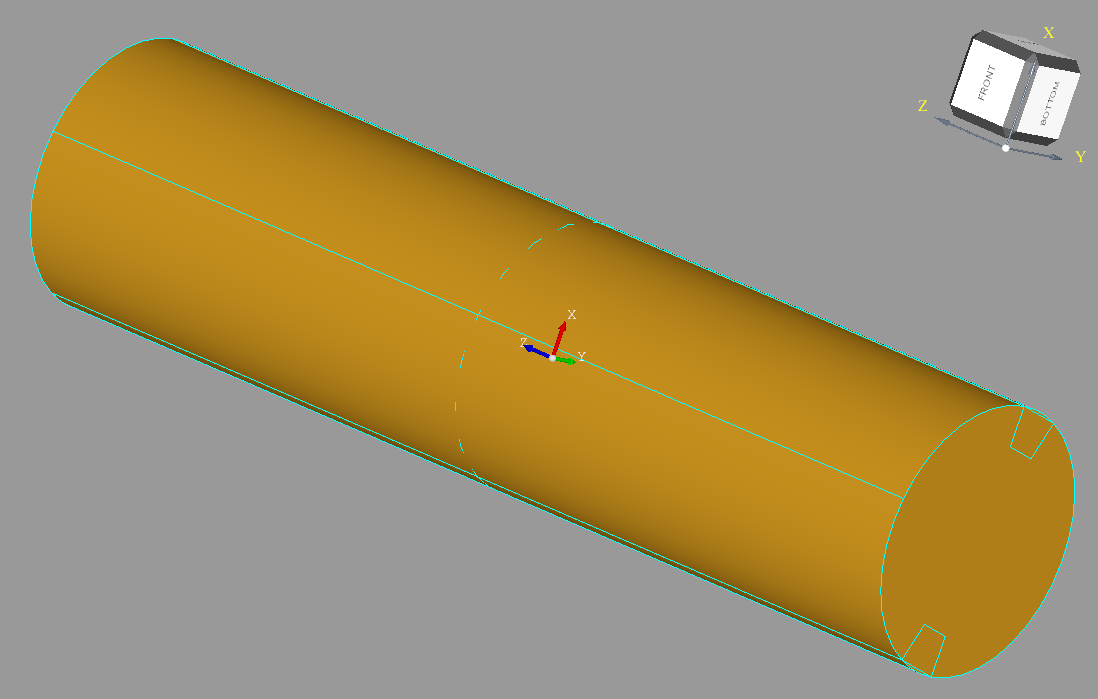使用Open CASCADE和BRepOffsetAPI_MakePipeShell创建螺旋槽钻头三维模型
引言
在机械工程和制造业中,钻头是最常用的切削工具之一。具有螺旋槽的钻头能够有效排屑并提高切削效率。本文将详细介绍如何使用Open CASCADE Technology (OCC)库,通过变截面扫掠技术重建具有复杂螺旋槽的钻头三维模型。
理论基础
变截面扫掠的数学原理
变截面扫掠可以表示为参数化曲面生成过程。给定一条路径曲线C(t)C(t)C(t)和一系列截面轮廓S(u,t)S(u,t)S(u,t),扫掠生成的曲面可以表示为:
S(u,t)=C(t)+R(t)⋅S0(u)S(u,t) = C(t) + R(t) \cdot S_0(u)S(u,t)=C(t)+R(t)⋅S0(u)
其中:
- C(t)C(t)C(t)是路径曲线,t∈[0,1]t \in [0,1]t∈[0,1]
- S0(u)S_0(u)S0(u)是基准截面轮廓,uuu是截面参数
- R(t)R(t)R(t)是沿路径的旋转矩阵,用于控制截面的方向
对于螺旋槽钻头,路径通常是直线或螺旋线,而截面轮廓则随着高度变化,模拟钻头的几何特征。

BRepOffsetAPI_MakePipeShell的工作原理
BRepOffsetAPI_MakePipeShell是Open CASCADE中用于创建管道状几何体的高级API。它通过将一系列截面沿着指定路径扫掠来生成复杂的三维形状。该算法能够处理:
- 变截面扫掠
- 截面旋转控制
- 实体或曲面生成
- 复杂的拓扑连接
完整实现代码
头文件包含和类定义
#include <iostream>
#include <vector>
#include <BRepOffsetAPI_MakePipeShell.hxx>
#include <BRepBuilderAPI_MakeWire.hxx>
#include <BRepBuilderAPI_MakeEdge.hxx>
#include <BRepBuilderAPI_MakeFace.hxx>
#include <BRepBuilderAPI_Transform.hxx>
#include <BRepPrimAPI_MakePrism.hxx>
#include <TopoDS_Shape.hxx>
#include <TopoDS_Wire.hxx>
#include <TopoDS_Face.hxx>
#include <gp_Ax2.hxx>
#include <gp_Pnt.hxx>
#include <gp_Dir.hxx>
#include <gp_Vec.hxx>
#include <gp_Trsf.hxx>
#include <gp_Circ.hxx>
#include <Geom_Circle.hxx>
#include <BRepAlgoAPI_Fuse.hxx>
#include <STEPControl_Writer.hxx>class DrillBitModeler {
private:std::vector<TopoDS_Shape> m_sections;double m_totalLength;double m_helixPitch;public:DrillBitModeler(double totalLength = 100.0, double helixPitch = 30.0);void GenerateSampleSections(int numSections = 20);TopoDS_Shape CreateSectionAtHeight(double z);TopoDS_Wire CreateStraightPath();TopoDS_Shape CreateDrillBit();TopoDS_Shape CreateDrillBitByExtrusion();bool ExportToSTEP(const TopoDS_Shape& shape, const std::string& filename);void CreateAndExportDrillBit();
};
构造函数实现
DrillBitModeler::DrillBitModeler(double totalLength, double helixPitch) : m_totalLength(totalLength), m_helixPitch(helixPitch) {// 参数验证if (m_totalLength <= 0) {std::cout << "Warning: Total length should be positive. Using default value 100.0" << std::endl;m_totalLength = 100.0;}if (m_helixPitch <= 0) {std::cout << "Warning: Helix pitch should be positive. Using default value 30.0" << std::endl;m_helixPitch = 30.0;}
}
截面生成算法
void DrillBitModeler::GenerateSampleSections(int numSections) {m_sections.clear();if (numSections < 2) {std::cout << "Error: Need at least 2 sections. Using default 8 sections." << std::endl;numSections = 8;}for (int i = 0; i < numSections; ++i) {double z = (double)i / (numSections - 1) * m_totalLength;TopoDS_Shape section = CreateSectionAtHeight(z);m_sections.push_back(section);}std::cout << "Generated " << m_sections.size() << " sections for drill bit modeling." << std::endl;
}
复杂截面创建
TopoDS_Shape DrillBitModeler::CreateSectionAtHeight(double z) {// 基础几何参数double mainRadius = 10.0;double progress = z / m_totalLength;// 动态几何参数 - 随高度变化double grooveDepth = 2.0 + 1.0 * progress;double grooveWidth = 3.0 + 1.0 * progress;// 创建主圆形截面gp_Circ mainCircle(gp_Ax2(gp_Pnt(0, 0, z), gp_Dir(0, 0, 1)), mainRadius);TopoDS_Edge mainEdge = BRepBuilderAPI_MakeEdge(mainCircle);TopoDS_Wire mainWire = BRepBuilderAPI_MakeWire(mainEdge);TopoDS_Face mainFace = BRepBuilderAPI_MakeFace(mainWire);// 第一个螺旋槽几何计算double angle1 = 0;double angle2 = grooveWidth / mainRadius;// 槽口边界点计算gp_Pnt p1(mainRadius * cos(angle1), mainRadius * sin(angle1), z);gp_Pnt p2(mainRadius * cos(angle1 + angle2), mainRadius * sin(angle1 + angle2), z);gp_Pnt p3((mainRadius - grooveDepth) * cos(angle1 + angle2), (mainRadius - grooveDepth) * sin(angle1 + angle2), z);gp_Pnt p4((mainRadius - grooveDepth) * cos(angle1), (mainRadius - grooveDepth) * sin(angle1), z);// 构建第一个槽口BRepBuilderAPI_MakeWire grooveWire1;grooveWire1.Add(BRepBuilderAPI_MakeEdge(p1, p2));grooveWire1.Add(BRepBuilderAPI_MakeEdge(p2, p3));grooveWire1.Add(BRepBuilderAPI_MakeEdge(p3, p4));grooveWire1.Add(BRepBuilderAPI_MakeEdge(p4, p1));TopoDS_Face grooveFace1 = BRepBuilderAPI_MakeFace(grooveWire1.Wire());// 第二个螺旋槽几何计算(对称布置)double angle3 = M_PI;gp_Pnt p5(mainRadius * cos(angle3), mainRadius * sin(angle3), z);gp_Pnt p6(mainRadius * cos(angle3 + angle2), mainRadius * sin(angle3 + angle2), z);gp_Pnt p7((mainRadius - grooveDepth) * cos(angle3 + angle2), (mainRadius - grooveDepth) * sin(angle3 + angle2), z);gp_Pnt p8((mainRadius - grooveDepth) * cos(angle3), (mainRadius - grooveDepth) * sin(angle3), z);// 构建第二个槽口BRepBuilderAPI_MakeWire grooveWire2;grooveWire2.Add(BRepBuilderAPI_MakeEdge(p5, p6));grooveWire2.Add(BRepBuilderAPI_MakeEdge(p6, p7));grooveWire2.Add(BRepBuilderAPI_MakeEdge(p7, p8));grooveWire2.Add(BRepBuilderAPI_MakeEdge(p8, p5));TopoDS_Face grooveFace2 = BRepBuilderAPI_MakeFace(grooveWire2.Wire());// 布尔运算合并几何体TopoDS_Shape section = BRepAlgoAPI_Fuse(mainFace, grooveFace1);section = BRepAlgoAPI_Fuse(section, grooveFace2);return section;
}
扫掠路径生成
TopoDS_Wire DrillBitModeler::CreateStraightPath() {gp_Pnt startPoint(0, 0, 0);gp_Pnt endPoint(0, 0, m_totalLength);BRepBuilderAPI_MakeEdge edgeMaker(startPoint, endPoint);if (!edgeMaker.IsDone()) {std::cout << "Error: Failed to create path edge." << std::endl;return TopoDS_Wire();}BRepBuilderAPI_MakeWire wireMaker(edgeMaker.Edge());if (!wireMaker.IsDone()) {std::cout << "Error: Failed to create path wire." << std::endl;return TopoDS_Wire();}return wireMaker.Wire();
}
主要建模算法
TopoDS_Shape DrillBitModeler::CreateDrillBit() {if (m_sections.empty()) {std::cout << "Error: No sections available for modeling." << std::endl;return TopoDS_Shape();}try {// 创建扫掠路径TopoDS_Wire path = CreateStraightPath();if (path.IsNull()) {std::cout << "Error: Path creation failed." << std::endl;return TopoDS_Shape();}// 初始化管道扫掠算法BRepOffsetAPI_MakePipeShell pipeShell(path);pipeShell.SetMode(Standard_True); // 生成实体模式std::cout << "Adding " << m_sections.size() << " sections to pipe shell..." << std::endl;// 添加所有截面for (size_t i = 0; i < m_sections.size(); ++i) {if (m_sections[i].IsNull()) {std::cout << "Warning: Section " << i << " is null, skipping." << std::endl;continue;}pipeShell.Add(m_sections[i]);}// 执行扫掠操作std::cout << "Building pipe shell..." << std::endl;pipeShell.Build();if (!pipeShell.IsDone()) {std::cout << "Error: PipeShell construction failed to complete." << std::endl;return TopoDS_Shape();}TopoDS_Shape result = pipeShell.Shape();if (result.IsNull()) {std::cout << "Error: Resulting shape is null." << std::endl;} else {std::cout << "PipeShell successfully created drill bit model." << std::endl;}return result;} catch (Standard_Failure& fail) {std::cout << "Exception in CreateDrillBit: " << fail.GetMessageString() << std::endl;return TopoDS_Shape();}
}
备用建模方法
TopoDS_Shape DrillBitModeler::CreateDrillBitByExtrusion() {if (m_sections.empty()) {std::cout << "Error: No sections available for extrusion." << std::endl;return TopoDS_Shape();}try {// 使用最后一个截面进行拉伸gp_Vec extrusionVector(0, 0, m_totalLength);BRepPrimAPI_MakePrism prismMaker(m_sections.back(), extrusionVector);if (!prismMaker.IsDone()) {std::cout << "Error: Extrusion operation failed." << std::endl;return TopoDS_Shape();}std::cout << "Extrusion method successfully created drill bit model." << std::endl;return prismMaker.Shape();} catch (Standard_Failure& fail) {std::cout << "Exception in CreateDrillBitByExtrusion: " << fail.GetMessageString() << std::endl;return TopoDS_Shape();}
}
模型导出功能
bool DrillBitModeler::ExportToSTEP(const TopoDS_Shape& shape, const std::string& filename) {if (shape.IsNull()) {std::cout << "Error: Cannot export null shape to STEP." << std::endl;return false;}try {STEPControl_Writer writer;IFSelect_ReturnStatus status = writer.Transfer(shape, STEPControl_AsIs);if (status != IFSelect_RetDone) {std::cout << "Error: Failed to transfer shape to STEP writer." << std::endl;return false;}status = writer.Write(filename.c_str());if (status == IFSelect_RetDone) {std::cout << "Successfully exported model to: " << filename << std::endl;return true;} else {std::cout << "Error: Failed to write STEP file." << std::endl;return false;}} catch (Standard_Failure& fail) {std::cout << "Exception in ExportToSTEP: " << fail.GetMessageString() << std::endl;return false;}
}
主控制流程
void DrillBitModeler::CreateAndExportDrillBit() {std::cout << "=== Drill Bit Modeling Process Started ===" << std::endl;std::cout << "Parameters - Length: " << m_totalLength << "mm, Helix Pitch: " << m_helixPitch << "mm" << std::endl;// 生成截面数据std::cout << "Phase 1: Generating cross-sections..." << std::endl;GenerateSampleSections(8);// 创建三维模型std::cout << "Phase 2: Creating 3D model..." << std::endl;TopoDS_Shape drillBit = CreateDrillBit();// 备用建模方法if (drillBit.IsNull()) {std::cout << "Primary method failed, attempting extrusion fallback..." << std::endl;drillBit = CreateDrillBitByExtrusion();}// 导出结果if (!drillBit.IsNull()) {std::cout << "Phase 3: Exporting model..." << std::endl;if (ExportToSTEP(drillBit, "drill_bit_model.step")) {std::cout << "=== Modeling Process Completed Successfully ===" << std::endl;} else {std::cout << "=== Modeling Failed: Export Error ===" << std::endl;}} else {std::cout << "=== Modeling Failed: Could not create 3D shape ===" << std::endl;}
}
独立可运行的测试程序
#include <iostream>// 包含上述所有DrillBitModeler类的实现int main() {std::cout << "OpenCASCADE Drill Bit Modeler - Standalone Test" << std::endl;std::cout << "=============================================" << std::endl;// 创建不同参数的钻头模型DrillBitModeler standardDrill(80.0, 25.0);standardDrill.CreateAndExportDrillBit();std::cout << std::endl << "Testing with different parameters..." << std::endl;DrillBitModeler longDrill(120.0, 35.0);longDrill.CreateAndExportDrillBit();return 0;
}
算法分析与优化
几何精度控制
在实际应用中,几何精度至关重要。可以通过以下方式优化:
// 精度控制参数
const double angularTolerance = 1e-6; // 角度容差
const double linearTolerance = 1e-5; // 线性容差
const double curvatureTolerance = 1e-4; // 曲率容差
性能优化策略
对于大型模型,可以采用以下优化措施:
- 截面简化:在保持几何特征的前提下减少截面复杂度
- 自适应采样:在曲率变化大的区域增加截面密度
- 并行处理:多截面生成可以并行化处理
错误处理与鲁棒性
完善的错误处理机制确保算法稳定性:
enum ModelingResult {SUCCESS = 0,EMPTY_SECTIONS = 1,PATH_CREATION_FAILED = 2,PIPE_SHELL_FAILED = 3,EXPORT_FAILED = 4
};ModelingResult ValidateModelingProcess() {if (m_sections.empty()) return EMPTY_SECTIONS;// 更多验证逻辑...return SUCCESS;
}
应用场景与扩展
工业应用
该技术可应用于:
- 定制钻头设计与制造
- 刀具磨损分析与再制造
- CNC加工路径优化
- 切削力仿真分析
算法扩展
可以进一步扩展的功能:
- 支持真实螺旋路径扫掠
- 添加切削刃几何特征
- 材料属性与物理仿真集成
- 参数化设计界面
结论
本文详细介绍了使用Open CASCADE Technology和BRepOffsetAPI_MakePipeShell创建螺旋槽钻头三维模型的完整解决方案。通过变截面扫掠技术,我们能够高效地重建复杂的几何形状,为机械设计和制造提供了强大的建模工具。
该方法的优势在于其数学严谨性、算法稳定性和工业实用性,为类似几何体的参数化建模提供了可复用的框架。
